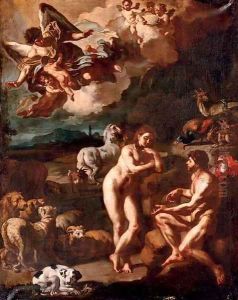Francesco Solimena Canale Di Serino Paintings
Francesco Solimena was an Italian painter and one of the most prominent and influential artists of the Baroque period in Naples. Born on October 4, 1657, in Canale di Serino, near Avellino, in the Campania region of southern Italy, Solimena’s first exposure to art was through his father, Angelo Solimena, who was also a painter. It was under his father's guidance that Francesco began his artistic training.
In his early years, Solimena’s style was influenced by the naturalism of Caravaggio and the vibrant compositions of Luca Giordano. He quickly developed a reputation for his skill and was commissioned to work on various churches and other significant buildings in Naples. One of his most important early works is the decoration of the San Nicola alla Carità in Naples, which he began in 1686.
Solimena's mature style blended the grandeur and drama of the High Baroque with a unique clarity and a vivid use of color. His work was characterized by dynamic compositions, robust figures, and a strong sense of movement, all of which are evident in his masterpiece, 'The Triumph of the Immaculate,' which he painted for the church of Gesù Nuovo in Naples in 1715.
Over time, Solimena's reputation extended beyond Italy, and he received commissions from royalty and high-ranking officials from across Europe. He also ran a large workshop that trained many artists, including his son, Orazio Solimena, and Sebastiano Conca, thus extending his influence on the next generation of Neapolitan painters.
Aside from religious and mythological scenes, Solimena also painted portraits and historical paintings. His works can be seen in many of the major museums of the world, including the Louvre in Paris, the Prado in Madrid, and the National Gallery in London.
Francesco Solimena passed away on April 5, 1747, in Barra, near Naples, at the age of 89. He left behind a legacy as one of the last great painters of the Italian Baroque, whose works continued to influence the artistic scene in Naples and beyond well into the 18th century.
